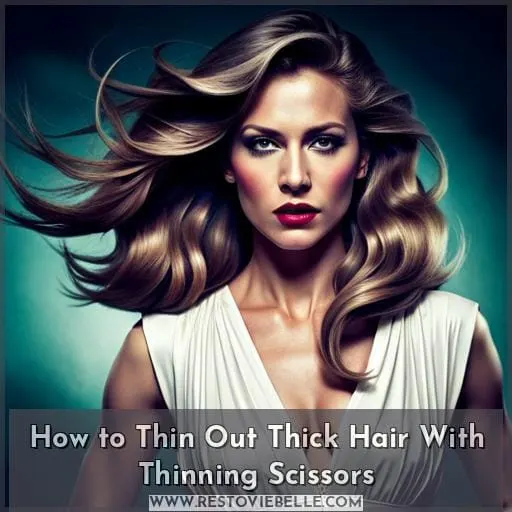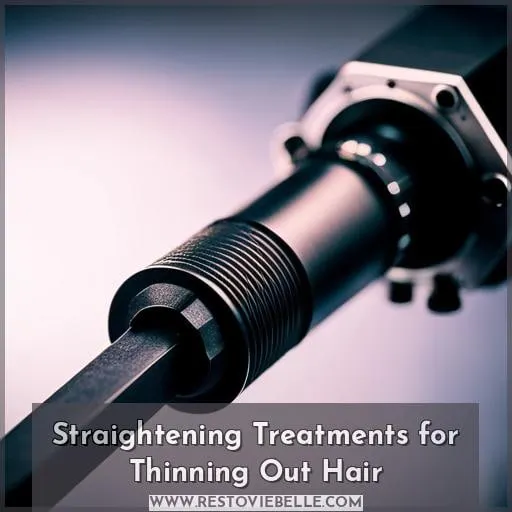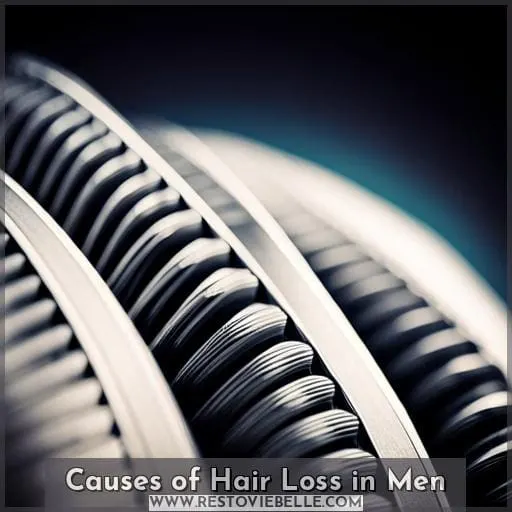This site is supported by our readers. We may earn a commission, at no cost to you, if you purchase through links.
 Are you looking for ways to thin out your hair? If so, you’re not alone. Many people with thick, heavy locks are starting to opt for a lighter look. It’s time to take matters into your own hands and learn how to thin out hair without sacrificing its health or style.
Are you looking for ways to thin out your hair? If so, you’re not alone. Many people with thick, heavy locks are starting to opt for a lighter look. It’s time to take matters into your own hands and learn how to thin out hair without sacrificing its health or style.
From using the right tools and products to making simple lifestyle changes, there are plenty of tips and techniques that can help give you long-lasting results.
Table Of Contents
Key Takeaways
- Thinning shears, styling creams, and heat protectants are essential tools and products for thinning hair.
- Proper washing, conditioning, and styling products are crucial for a hair care routine revamp.
- DIY methods like thinning scissors or razors should be used every 4-8 weeks to thin out hair.
- Managing frizz can be done using apple cider vinegar instead of conditioner, and thinning out hair can reduce heaviness and improve texture.
How to Thin Out Hair
Are you looking to thin out your hair? It can be a daunting prospect, but with the right tools and products, an updated hair care routine, lifestyle changes, and considerations for potential results, it’s possible to achieve the desired look.
Start by gathering necessary items such as thinning shears from beauty supply or department stores. Also, make sure to have styling products like creams and serums, heat protectant, and custom haircare products depending on your hair type.
Additionally, update your routine by washing less frequently with cold water instead of hot water.
Finally, consider making lifestyle adjustments such as altering your diet or addressing hormone issues naturally if needed before attempting any drastic measures in order to get that perfect style!
Necessary Tools and Products
To thin out your hair, you’ll need to purchase the right tools and products – like thinning shears from beauty supply stores, styling creams, and serums for volume control, heat protectants for blow-drying or flat ironing – as well as custom haircare items tailored to your unique needs.
DIY methods such as using thinning scissors or hair clips can also help reduce bulk in thicker areas without damaging the follicles. Professional advice is essential when it comes to reducing overall bulk safely. Stylists employ techniques like slide cutting and point cutting with razors.
General considerations should include lifestyle changes such as washing less often with cold water while avoiding deep conditioning too frequently. Additionally, managing frizz can be done by using apple cider vinegar instead of conditioner.
Thinning out your mane will add texture, volume, and style while making manageability easier!
Update Hair Care Routine
Revamp your hair care routine to keep thick hair looking stylish and light! Start with a proper wash, conditioner, heat protectant, and styling products. For DIY methods like thinning scissors or razors, use them every 4-8 weeks for even results.
Professional services such as slide cutting or point cutting can be done for more precise outcomes. Avoid deep conditioning too often to prevent buildup while maintaining natural oils by shampooing 2-3 times per week using cold water.
Considerations and Potential Results
Before attempting to thin out your hair, consider the potential results and adjust lifestyle habits accordingly – as they say, an ounce of prevention is worth a pound of cure. Hair thinning methods, like using shears or razor cutting, can create texture and volume if done correctly.
However, managing frizz caused by styling thick hair requires specialized haircare products for nourishment, plus professional help every 6-8 weeks to keep it healthy.
Additionally, short hairstyles may require layering during growth stages, while longer styles benefit from slide cutting techniques for even weight distribution.
Lifestyle Changes
Altering your lifestyle habits, such as diet and hormone regulation, can help you achieve the thinned-out look you want while nourishing your hair. Incorporate dietary adjustments to include healthy fats like avocado or salmon. Address any underlying hormone issues with natural solutions for best results.
Create a wash-and-care routine that works for you. Shampoo less frequently but use volume-reducing products when needed. Make thinning out hair part of a monthly ritual to maintain the desired style without overdoing it.
With these tips in mind, feel confident knowing that this transformation will not only bring about better styling options but also healthier locks!
How to Thin Out Thick Hair With Thinning Scissors
Choosing the right thinning scissors is crucial to achieving optimal results. To start, divide your hair into 2-3 inch sections and clip up each section before cutting with a 45-degree angle about two to three inches from the end of the hair shaft for even thinning.
Selecting the Right Scissors
Choosing the right thinning scissors is key for achieving your desired style. There are different scissor types available, such as texturizing shears or razor combs, that can help you achieve the perfect look when it comes to thinning out thick hair.
Thinning techniques like slide cutting and point cutting with these tools also require maintenance tips. For example, using heat protectants and avoiding deep conditioning too often can help maintain healthy hair texture while controlling frizz levels.
Seeking professional assistance from a stylist will ensure optimal results for smoothing out your locks and reducing volume without sacrificing shine or quality of your tresses.
Dividing Hair for Thinning
Divide your hair into 2-3-inch-wide sections for an even thinning. The sectioning technique is key: this way, you’re able to control the amount of hair being cut while ensuring a consistent look. Make sure each section has the same width and density so that when using DIY thinning shears, you can reduce volume without sacrificing consistency.
To make thick hair thin quickly and easily, divide it into three or four sections before beginning the process.
Clipping Up Hair Sections
Hold one section away and clip the rest, focusing on the ends. Use bobby pins to hide braids or separate sections for even thinning. Cut down the shaft with the serrated edge facing downwards at a 45-degree angle, around 2-3 inches from the ends.
Apply blow dry cream before styling hair if necessary. This will help reduce volume and frizz when using heat tools later on.
Sectioning off thick hair is key when it comes to successful thinning techniques.
Step-by-Step Cutting Technique
Using a 45-degree angle, carefully cut the ends of your hair with the serrated edge facing down.
Focus on one section at a time and avoid over-thinning by using products sparingly before cutting.
Experiment with different thinning frequencies to find what works best for you. Regular layering can help if you have shorter hair or tend towards thicker strands.
For added protection from heat styling, use protective sprays and creams regularly.
With proper care through heat protectant treatments and DIY thinning methods like scissors or razor cuts, thick hair can become thinner while still maintaining its natural texture – no straightening treatment required!
Developing an effective styling routine is essential when making thick hair look thinner. Follow these steps as part of your haircare regimen to achieve effortlessly beautiful results every day.
How to Naturally Make Thick Hair Look Thinner
You can naturally make thick hair look thinner by altering lifestyle habits and trying new styling products.
- Make dietary changes, such as eating more protein-rich foods, to promote healthy hair growth.
- Try different hairstyles that create the illusion of thinness without actually cutting any strands.
- Use moisturizing haircare products suited for your particular texture and condition of your locks. Lighter formulas may help manage bulk better than heavier ones like creams or mousses, which can add too much weight instead of reducing it.
- Make routine adjustments in washing frequency. Use cold water instead of hot when needed for an instant volume reduction effect on frizzy hair types.
- Adjust lifestyle habits such as stress management techniques like yoga or meditation, which have been proven effective at improving overall health, including one’s tresses health.
With these tips, you’ll be able to maintain healthier-looking locks without compromising their natural beauty or resorting to excessive thinning scissors treatments every now and then…
Straightening Treatments for Thinning Out Hair
Experiment with straightening treatments to give your hair a sleek, polished look and reduce bulk. Hair straightening is an easy way to thin out thick locks without using shears or scissors. When blow-drying, use a concentrator nozzle on the lowest fan setting for control, and apply heat protectant beforehand to avoid dehydration or damage from high temperatures.
Flat irons can be used for additional styling but should also be accompanied by heat protection products such as serums and creams. Avoid sticky products like gel or mousse that add too much volume. Instead, opt for lighter protein-based conditioners suitable for medium-textured hair.
Lastly, don’t forget about routine haircare maintenance. Shampooing 2-3 times per week preserves natural oils, while washing with cold water reduces frizziness and overall volume of your tresses!
Causes of Hair Loss in Men
For many men, hair loss can be a frustrating source of insecurity. It’s important to understand the possible causes in order to determine the best solution.
Male pattern baldness is one common cause that results from genetics and hormones. Stress-induced alopecia can also lead to thinning or shedding due to physiological factors like prolonged anxiety or illness.
Medication-related hair loss may occur as a side effect of certain drugs such as chemotherapy treatment medications, antidepressants, and blood pressure medications. Hormonal shifts caused by puberty, thyroid issues, pregnancy, or menopause are known culprits for thinning out hair in both men and women alike.
Nutritional deficiencies may leave your locks lacking luster due to nutrition imbalances from poor diets or excessive dieting habits.
Understanding these potential underlying causes will help you make an informed decision when it comes time for choosing treatments geared toward restoring fullness back into your mane-scape!
Conclusion
Thinning out hair can be a great way to reduce heaviness, improve texture, and volume, and create a more manageable style. It’s estimated that up to 40% of men will experience hair loss, and thinning out hair can become a necessary part of their hair care routine.
However, it’s important to consider the necessary tools, products, and techniques when thinning out hair to achieve the desired results. Thinning scissors can be used to evenly clip up sections of hair, while thinning shears can be used to reduce bulk at the ends.
Additionally, following a suitable hair care routine, using the right products, and making lifestyle changes can all help naturally make thick hair look thinner. Knowing how to thin out hair with the right tools and techniques can give your style a boost.









